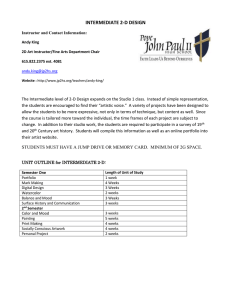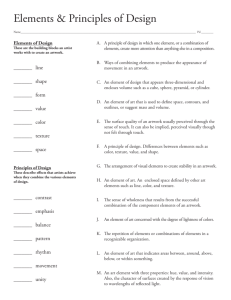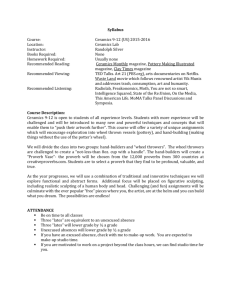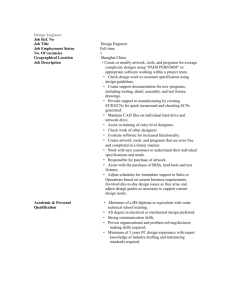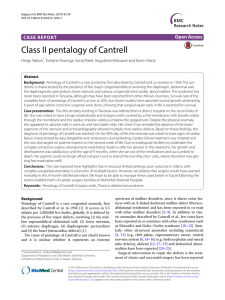4. A P Art 2 D 15 16 4. AP Art 2D 15
advertisement
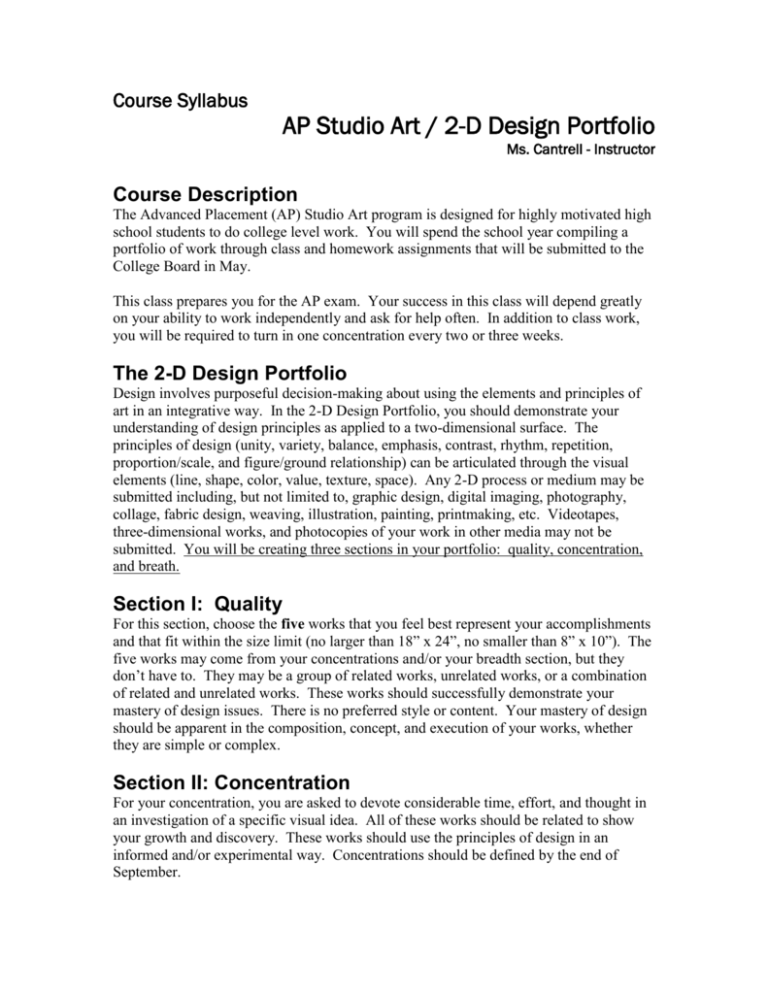
Course Syllabus AP Studio Art / 2-D Design Portfolio Ms. Cantrell - Instructor Course Description The Advanced Placement (AP) Studio Art program is designed for highly motivated high school students to do college level work. You will spend the school year compiling a portfolio of work through class and homework assignments that will be submitted to the College Board in May. This class prepares you for the AP exam. Your success in this class will depend greatly on your ability to work independently and ask for help often. In addition to class work, you will be required to turn in one concentration every two or three weeks. The 2-D Design Portfolio Design involves purposeful decision-making about using the elements and principles of art in an integrative way. In the 2-D Design Portfolio, you should demonstrate your understanding of design principles as applied to a two-dimensional surface. The principles of design (unity, variety, balance, emphasis, contrast, rhythm, repetition, proportion/scale, and figure/ground relationship) can be articulated through the visual elements (line, shape, color, value, texture, space). Any 2-D process or medium may be submitted including, but not limited to, graphic design, digital imaging, photography, collage, fabric design, weaving, illustration, painting, printmaking, etc. Videotapes, three-dimensional works, and photocopies of your work in other media may not be submitted. You will be creating three sections in your portfolio: quality, concentration, and breath. Section I: Quality For this section, choose the five works that you feel best represent your accomplishments and that fit within the size limit (no larger than 18” x 24”, no smaller than 8” x 10”). The five works may come from your concentrations and/or your breadth section, but they don’t have to. They may be a group of related works, unrelated works, or a combination of related and unrelated works. These works should successfully demonstrate your mastery of design issues. There is no preferred style or content. Your mastery of design should be apparent in the composition, concept, and execution of your works, whether they are simple or complex. Section II: Concentration For your concentration, you are asked to devote considerable time, effort, and thought in an investigation of a specific visual idea. All of these works should be related to show your growth and discovery. These works should use the principles of design in an informed and/or experimental way. Concentrations should be defined by the end of September. Section III: Breadth The artwork you submit should demonstrate your understanding of the principles of design, and that you are thoughtfully applying these principles while composing your art. The best demonstrations of breadth clearly show a range of conceptual approaches to 2-D design. For samples of student work in this area go to: http://apcentral.collegeboard.com/studio2D Grade Level 11th and 12th grade Prerequisite Introduction to Art and Beginning Drawing/Painting. Required Reading Thoughtful consideration of the elements and principles should be displayed in each piece. You may use class textbooks and you should research art and artists online. Method of Instruction Studio work, presentations, demonstrations, group discussions and critiques, silent reading, written assignments, guest speakers, and student art shows. At least one trip to a gallery or museum is required each semester. Please take advantage of free art walks in our area. Level of Application Students produce 24-30 works of art which meet the requirements for the AP studio art curriculum as stated in the College Board Instructor’s handbook. Students choose their five most creative and strongest art works for inclusion in the quality section of their exam. Plagiarism Students will understand how to work with artistic integrity as well as learning what constitutes plagiarism. Students must develop their own work so that it moves beyond duplication. Draw what you SEE in the world. No drawings from published images. Students need to learn to draw without the crutch of someone else’s composition or flattening of space. Concentration Section Students produce all their artwork for this section outside of class. AP Teacher monitors their progress by setting deadlines for thumbnail sketches, plans and rough drafts. Final works are turned in every two weeks. A minimum of twelve (12) concentrations are submitted in slide form for the exam. Deadlines are firm and artwork will be penalized by ½ a grade each day it is late. Average time spent on a concentration is six hours. Students will use informed decision-making and problem-solving skills in an ongoing process to develop and select the 12 pieces of work in this section. Educational Goals (Program Outcomes) 1. Art History: Students will look at the development of visual art as they examine the relationship between art and its social context. Study of art history is the perfect place to learn about a variety of concepts and techniques as the student develops his/her own voice and style. 2. Art Methodology: The artwork submitted will demonstrate understanding of the principles of design. 3. Art Techniques: Drawing: gesture, contour, tone-ground, value studies Drawing Media: charcoal, felt pens, oil pastels, pen & ink, graphite Painting: opaque and transparent, layering, use of washes and brushes Painting Media: watercolor, acrylics, mixed media, collage Graphic Arts: design and layout procedures, camera-ready art Graphic Art Media: computer graphic programs, printmaking 4. Cultural Enrichment: Students are encouraged to visit art galleries and art museums for a well-rounded and diverse art education. Student Goals (Student Outcomes) 1. Art History: Students will describe, analyze, and interpret works of art in this four step critiquing process. Art history units will include a variety of art styles beginning with the Renaissance to Post Modern Art. 2. Art Methodology: Students will demonstrate purposeful decision-making about using the elements and principles of art in an integrative way. 3. Art Techniques: Using a variety of art media, students will produce still life drawings, portraits, figure studies, abstract works, posters, and collages. 4. Cultural Enrichment: Student artwork will reflect their own creativity and originality but the content and process may be derived from experiences they have had on gallery, museum, or art shows. Evaluation There are standards of quality in student work, expectations based on the range of accomplishments of other AP art classes, and the evidence of thought, care, and effort demonstrated in the work. All of these elements are discussed with students, individually and in class critiques. Students are encouraged to develop verbal and written literacy about their works, and we use the AP scoring rubric for individual and group evaluation. Students examine their work and discuss how to move it from a middle-range piece to a high-level composition. Students will critique their artwork and their classmate’s artwork using a variety of methods. Formal critiques will involve instructor feedback about the works created by the students. Please refer to the AP Evaluation Rubric in the following page for further explanation. AP Evaluation Rubric Assess your selected portfolio work and score it on the following criteria: Poor Moderate Good Strong Excellent Materials are used well; technique Is excellent 1 2 3 4 5 Inventive/Imaginative/ Original 1 2 3 4 5 Evidence of thinking; clear visual intent 1 2 3 4 5 Successful engagement with elements and principles of design 1 2 3 4 5 Link between form and content is excellent. 1 2 3 4 5 Sensitive/Evocative 1 2 3 4 5 If you have not scored your work consistently in the 4 or 5 range, now assess what the strengths and weaknesses are, and how to rework the piece and raise it to a 5. Explain your rationale in a paragraph, considering: 1. Have you done anything special with the use of the art elements (line, color, shape, texture, value)? 2. What are some of the dominant shapes, expressive forms, color schemes, and textures that carry significance in this artwork? 3. Is the work ordered/balanced? Or chaotic/disturbing? What makes for the order or chaos? Would you use words such as unity, variety, contrast, balance, movement, and rhythm to describe formal characteristics of this work? 4. Describe the quality of execution and technique. What gives the work its uniqueness? 5. Does the work evoke any feelings? To what do you ascribe your feelings (the use of color, shape, technique, theme)? 6. Is there symbolism used in the work to convey meaning other than what one sees? 7. What is your general impression of the work? What did you want the viewer to think about? Did you successfully get your message across? Discuss if the work is a significant success, why or why not, and support our judgment with evidence. Grading Grading will be based on a percentage of various activities on the following 100% scale. Points are earned by participating in class each day and completing assignments on time. Art projects are the largest portion of your grade but daily work habits, notes and quizzes are also part of this course. 93 – 100% 90 – 92% 88 – 89% 83 – 87% 80 – 82% A AB+ B B- 78 – 79% 73 – 77% 70 – 72% 68 – 69% 63 – 67% C+ C CD+ D 60 – 62% below 60% DF Late Work Assignments will be penalized by half of a grade each day they are late. Absences Students who are absent will be required to turn in all homework assignments on the day they return to class. A schedule is given and everyone is aware that missed tests, quizzes, and assignments must be made up or turned in the day of their return unless they have missed notes. It will be their responsibility to gather these from other students. It is also the responsibility of the student to find out what work they missed while absent. No credit will be given due to truancy or unexcused absence. Assisting students in establishing lifelong habits of reliability and promptness is an instructional objective of this particular course. Progress toward this goal will be measured, at least in part, by tracking student attendance. Therefore, a student’s grade or credit in this class may be adversely affected by reason of tardiness or absence. Tardy Policy After the second tardy, students receive 2% off their grade for each tardy up to 5 tardies. If a student receives 5 tardies then they are referred to the Dean of Students. Materials and Fees There is a $30 art fee to cover art supplies. Pay the cashier and show me your receipt. Care of art materials are the students responsibility and they will be assessed a replacement fee for any supplies not returned in the same condition. Students with financial hardships see the counselor or Ms. Cantrell. This will be kept confidential. Each student is may need to purchase art supplies for home use in order to complete concentration pieces. Overarching Goals of Visual Art Education Accomplished teachers hold high expectations that their students will be able to communicate ideas and feelings through the creation of works of art; interpret, evaluate, and respond to complex characteristics of works of art, design, and visual culture; understand the roles and functions of artists and works of art in cultures, times and places; perceive, understand, question, and appreciate the diverse meanings and values of works of art; and make valid connections among the content of art, other subject areas in the curriculum, and everyday life. Classroom Expectations Good students are expected to constantly be working to improve their skills. Successful students avoid wasting of time, excessive social conversation, and any behavior that detracts from an organized, safe, and pleasant art studio and classroom. Please be advised that students who spend most of their time talking and visiting during class often fail to complete assignments or do inadequate jobs. Violation of this advice may also result in dismissal from the course or time before or after school. General Student Conduct Rules: 1. Be in your assigned seat and ready to work when the bell rings. 2. Quietly listen to the teacher. 3. Work in a professional and mature manner. 4. Take proper care of all tools and supplies. 5. Clean up any mess you make. 6. No food or drinks except water. 7. No listening devices or cell phones. 8. Follow all school rules while in this classroom. I am looking forward to working with you this year. This document should be the first page of the student’s notebook. Please read the next page and sign that you have read and understood this letter. I can be reached at: Phone: (425)413-6200 extension: 9041 Email: aweber@tahomasd.us Sincerely, Amy Cantrell Amy Weber-Cantrell NBPT EAYA Art RETURN THIS PAGE TO MS. CANTRELL We have read the introductory letter on the previous pages and agree to abide by the terms and conditions. Please complete this form, and return it to Ms. Cantrell for assignment credit. Students must keep the course syllabus in their notebook for future reference. An additional copy will be available on SWIFT. Thank you for your cooperation. ______________________ Date ______________________________________ Print Student Last Name _______________________ First Name ______________________________________ Student Signature ______________________________________ Parent/Guardian Signature Comments or concerns from parents: _____________________________________________________________________ _____________________________________________________________________ _____________________________________________________________________
